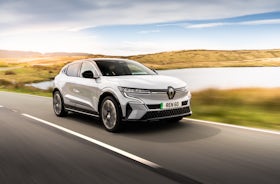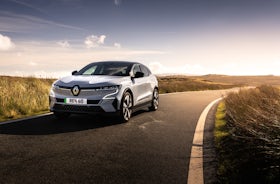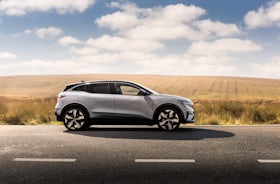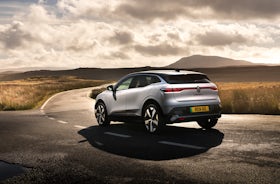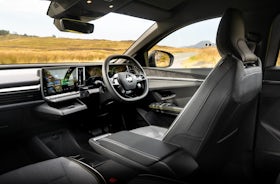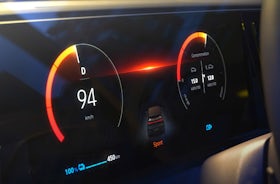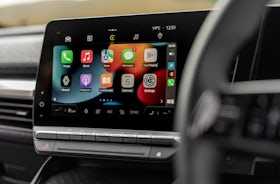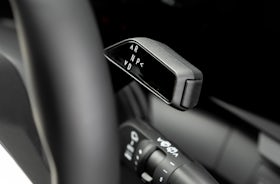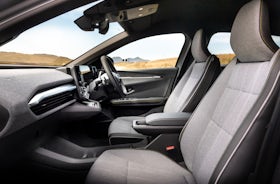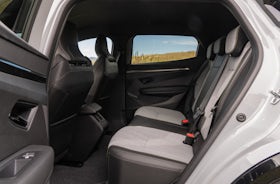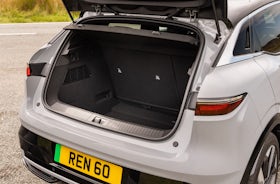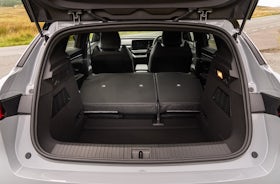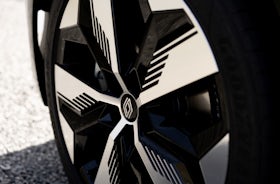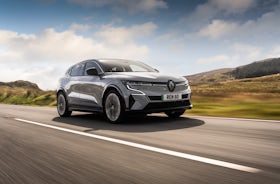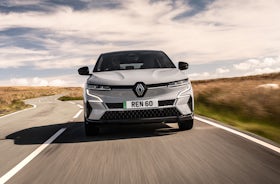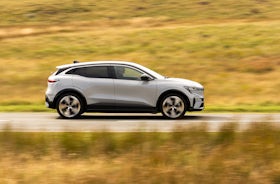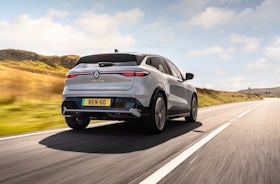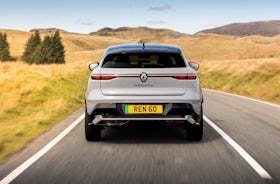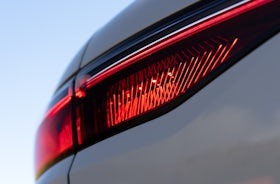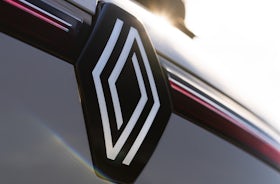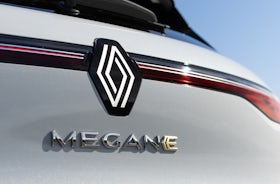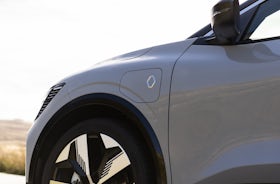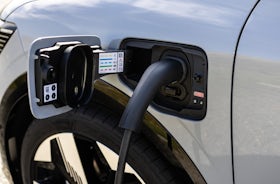Renault Megane E-Tech Electric Review & Prices
The Renault Megane E-Tech Electric is a super-stylish way to go electric, but its good looks come at a compromise on practicality
- Cash
- £29,853
- Monthly
- £301*
- Used
- £18,495
Find out more about the Renault Megane E-Tech Electric
Is the Renault Megane E-Tech a good car?
If you’re looking for a stylish electric hatchback, the Renault Megane E-Tech is one worth considering. It’s the sort of car to be looking at if you’re considering an electric hatchback such as the Volkswagen ID3, Cupra Born or MG4 EV.
This Megane is like one of your mates who’s suddenly decided to take on a vegan, eco-conscious lifestyle. Gone are its petrol versions, with just electric power coming in its place, plus a bunch of eco-friendly materials. But more on those shortly.
There’s no questioning that the Renault Megane E-Tech Electric is a looker. A striking front-end design, sleek roofline and strong selection of two-tone colour choices certainly allow it to stand out. You’ll get 18-inch wheels as standard, but there’s a set of optional 20-inch alloys if those aren’t large enough for you.
It’s just as stylish inside, too. You’re met immediately with a two-spoke steering wheel that offers something of a throwback feel (if you look beyond all the buttons), plus a host of recycled fabrics that look and feel the part. You can go for leather on top-spec cars, though.
Renault Megane E-Tech: Electric range, battery and charging data
Range: 280 miles
Efficiency: 3.9 miles per kWh
Battery size: 60kWh
Max charge speed: 130kW
Charge time AC: 9hrs 11mins, 0-100% at 7kW
Charge time DC: 1hr 14mins, 0-80% at 130kW
Charge port location: Right front
Power outputs: 215hp
Directly in your line of vision is a 12.3-inch digital driver’s display that’s crisp and very configurable. To the side of that, you’ll find a portrait-set infotainment system that serves as evidence car manufacturers should bin off developing their own software and leave it to tech companies.
This isn’t a dig at Renault, as it uses a new Google-based system here in the Megane. It’s super-sharp, dead easy to use and comes with impressive Google Maps integration without charging you any extra for the privilege. It helps that the assistant for voice controls is easy to use and rarely mishears you, too.
However, the Megane is let down a little in the practicality stakes. Its roofline helps the design, but it does mean headroom in the back isn’t great, although there’s a good amount of knee room.
The Renault’s boot comes in at a healthy 440 litres, which is comfortably more than the VW ID3’s 385 litres. However, it’s hindered by a massive lip that can make loading difficult — and storing the charging cables under the boot floor will mean playing real-life Tetris every time you want to charge while carrying a full load.
The Megane comes with just the one power output, giving a 220hp instant surge of torque. It comes with a 60kWh battery, which offers 292 claimed miles between charges. In other markets there is also a cheaper and lower-powered 130hp version with a choice of battery sizes, but this isn’t offered in the UK.
As all get the same 220hp motor setup, choose between the Techno or Iconic trim to get the best out of your Megane
Hook it up to a 130kW rapid charger you’ll be able to complete a full charge in a little over 70 minutes. A 7.4kW home wall box charger will take just over 9 hours.
Around town, the Megane’s light and direct steering make zipping around a breeze. That said, massive pillars at the front and a narrow rear window result in pretty poor visibility. You can have a rear-view camera displayed on the mirror to help the latter issue, but it’ll cost you.
Take it out on the motorway and its soft-set suspension results in a smooth ride, though this combined with light steering does detract from your ability to have fun on twisty roads.
So if you’re looking to add some style and sustainability to your driveway, the Renault Megane E-Tech should have a place on your shortlist. Head on over to our Renault deals page to see how much you can save on a Megane E-Tech when you buy through carwow.
You can also save money on other Renaults, or if you’re in the market for a used model instead, we have a marketplace for that as well. If you want to change your car altogether, you can sell your car with our trusted dealers bidding on your car so you can get the best price.
How much is the Renault Megane E-Tech?
The Renault Megane E-Tech Electric has a RRP range of £34,005 to £38,005. However, with Carwow you can save on average £6,142. Prices start at £29,853 if paying cash. Monthly payments start at £301. The price of a used Renault Megane E-Tech Electric on Carwow starts at £18,495.
Our most popular versions of the Renault Megane E-Tech Electric are:
| Model version | Carwow price from | |
|---|---|---|
| EV60 160kW Techno Comfort Range 60kWh 5dr Auto | £29,853 | Compare offers |
It’s far from the cheapest electric car on sale but the Megane E-Tech at least offers reasonable value for money. In fact, in its most affordable ‘Equilibre’ specification, it’s actually significantly cheaper than the Volkswagen ID3, although if you want a cheaper ID3 you can just buy a Cupra Born, which has all of the same battery and tech as the Volkswagen, but which is closer to the Renault on price.
The fly in the Megane’s ointment is the MG 4, which even in Long Range form, with a 281-mile range, undercuts the Megane by several thousand pounds.
Performance and drive comfort
The Renault Megane E-Tech’s greatest asset is its comfort — it’s exceptionally refined and smooth to drive. It can also corner with enthusiasm, but can’t quite match the MG 4 or Cupra Born for a B road blast
In town
The Megane has brake energy recovery — which slows you down by using the drag of the electric motor — that you can adjust with paddles behind the steering wheel. Set it for maximum braking, and you get useful one-pedal driving around town but you still need to use the physical brakes to come to a complete stop, and they do feel a bit over-sensitive and snatchy.
The Megane has a very tight 10.4-metre turning circle, which makes it super-manoeuvrable in town, and that combined with the light steering makes mini-roundabouts and u-turns a doddle. The downside is visibility — you get a good forward view, and good door mirrors, but the rear window is a proper letter-box, and you’re not going to be able to see much behind you. The rear windscreen wiper also only clears a tiny semi-circle of the screen. It’s not helped by chunky rear roof pillars so there’s a massive blind spot when pulling out of angled junctions.
The Megane is quite light for an electric car — around 1,700kg — which means its suspension isn’t too overwhelmed, so the ride around town, although quite taut, isn’t too firm and actually feels quite sophisticated.
On the motorway
The 220hp motor means that it’s easy to pile on the speed from 40mph upwards when joining a fast-flowing motorway, although you might feel a little tug on the steering when you give it full power. It’s a quiet cruiser at 70mph too, thanks to Renault doing a lot of work to keep wind and road noise down, but there is a distinct rumbling noise from the airflow under the car. At motorway speeds, your range will probably drop to around 200 miles, incidentally.
On a twisty road
On a country road, it’s best to have the brake regeneration in its middle setting, which helps you to balance the Megane as you turn into a corner. The whole car feels really natural and at home when you point it down a twisty road. It has a good balance between comfort and precision, and the steering encourages you to have a little fun as you go — it’s responsive and accurate, and you can make it a little heavier by turning on Sport mode.
The electric motor responds more quickly when you switch on Sport too, a bit too much so as the response can be too sudden, and a touch ‘flighty’ so Comfort is the best setting. The Megane is front-wheel drive, so it doesn’t feel quite as sharp on a twisting road as the rear-wheel drive likes of the MG 4 or Cupra Born.
Space and practicality
The Megane has a large boot, but rear space isn’t as good as it should be
The front of the Megane’s cabin is reasonably spacious and has useful storage areas, but the storage box under the armrest is a bit small, and the placement of the USB sockets in front of the armrest, in their own little cubby-hole, is kind of awkward. There’s a huge open storage area down by your feet though, which has moveable cup holders, or you could take the cup holders out entirely and fill that space with a laptop bag.
There’s a little shelf just below the infotainment screen, which is home to the wireless phone charger if you’ve specced the car with one, but which is a bit too small to be useful for anything else. The glovebox is adequate, but no more than that, although the door bins — lined with felt so that loose items don’t rattle — are big, and can hold a two-litre bottle of water (or fizzy drink, if you’re feeling frisky).
The driving position is good, with lots of adjustment, and if the steering wheel is a slightly odd, square-ish shape (cough, Austin Allegro, cough) then at least it feels good to hold.
Space in the back seats
Knee room in the Megane’s back seats is pretty good, although not quite as generous as you get in the Volkswagen ID3 or Cupra Born. Headroom is a little tight, as the Megane’s roof sweeps down so much, but it’s enough to be getting on with. The problem in the back is space for your feet — the front seats are set low down, so there’s nowhere for rear seat passengers to poke their toes. Better leave the hiking boots at home and wear ballet slippers… The low-mounted rear seat also means that taller passengers won’t have good under-thigh support.
The Megane is too narrow to get three full-size adults comfy in the back, as the centre seat is too small and the roofline curves inwards, meaning that those in the outer seats have to lean their heads. Oddly, there are roof-mounted grab handles for rear seat passengers, but not for the front-seat passenger.
You do at least get ISOFIX points in the two outer rear seats, and in the front passenger seat. The rear anchors have flip-up covers, which makes them really easy to use and you do get good door bins and map pockets in the seatbacks. You will have to do without a rear armrest though, and only higher-spec models get rear USB sockets. Oh, and the rear windows don’t wind down fully. If you want an EV that’s more practical in the back, look at a Kia Niro EV.
Boot space
There’s a tiny little button built into the boot-lid that opens up the rear, but the boot itself is not tiny — at 440 litres, it has more space than the VW ID3, the MG 4, or the Cupra Born, which sit at 385, 363 and 385 litres respectively. Only the Kia Niro has a bigger boot in this class. There’s a problem though, which is that the boot is deep, rather than long or wide, so it’s not so good for carrying bulky single items. Meanwhile, the load lip is huge, so bigger items will have to be (carefully, now) heaved in over that.
Helpfully, though, there is a little storage area under the boot floor which allows you to stash your charging cable, However, the Megane doesn’t have an adjustable boot floor, which means when you fold down the back seats, there’s a massive lip over which heavier items have to be levered, and nor has Renault fitted clips to prevent the rear seatbelts getting trapped when you pop the seats back upright again. There’s also no load-through ‘ski hatch’, or any extra boot under the bonnet (a ‘frunk’ or, if you prefer, a ‘froot’) to compensate.
Interior style, infotainment and accessories
The Megane’s cabin gets some proper high-tech, courtesy of Google, but beware of the quantity of buttons and switches around the steering wheel, as it’s not the most user-friendly of layouts
The Megane’s interior looks every bit as handsome as the outside, and that starts with the twin-screen dashboard layout. Unlike some other cars with digital screens, Renault doesn’t try to pretend that the infotainment screen and the instrument panel are one big screen. In fact, the two screens are actually separated by an extra air-vent.
For the most part, the cabin looks and feels expensive, especially the attractive fabric finish to the top of the dashboard, but you will find cheaper, scratchy plastic on the tops of the doors and around the lower reaches of the interior.
In European markets, the central touchscreen can be upgraded to a big, almost-Tesla-style, portrait type screen, but here in the UK we must make do with a standard, square-ish nine-inch setup. It’s fine, if not quite as visually impressive, but the good thing is that Renault has farmed out the development of the screen’s software to Google, so you get some useful tech included.
There’s Google Assistant (you can shout ‘Hey, Google’ at the dashboard and ask for all sorts of functions), Google Play store for extra apps, and of course Google Maps. There’s also standard connections for Apple CarPlay and Android Auto so that you can use your phone, both connecting wirelessly. Plus, there’s ambient lighting that you can change yourself, or set it to adjust automatically during the day. You can even change the noise that the parking sensors make and change the volume of the indicator clicks.
The 12.3-inch instrument display in front of the driver is excellent, with lots of information and you can change the layout and the colours according to your taste. One annoying thing to note is that the Megane uses a gear selector mounted on the steering column, which saves space on the centre console. That’s fine, but there’s also the column stalk for the wipers back there, as well as a little pod for fingertip stereo controls.
Combine that with the little button on the edge of the steering wheel centre that controls Sport mode and you just have too many buttons and levers on one side of the wheel. Mind you, it’s good that you have a little star-marked button on the steering wheel which you can set to switch on or off multiple items, including a setting that turns on both front heated seats at the same time. We also like that you can easily switch the lane-keeping assistance on and off with a button, rather than digging around on the touchscreen.
Electric range, charging and tax
With the bigger 60kWh battery pack (the only one Renault UK has on sale at the moment) the Megane E-Tech (not to be confused with the old Megane hybrid, which was also badged as E-Tech) has a maximum claimed range of 281 miles on a charge. In mixed driving conditions, that will probably fall to around 200 or 220 miles, which isn’t particularly brilliant, but the Megane has a bit of a charging ace up its sleeve.
On a DC high-powered fast charger, the Megane will charge at up to 130kW, which is enough to get you from around 20 miles of range to around 180 miles in just 30 minutes. That’s good, but not exceptional. What’s better is the slower AC charging. The Megane has a 22kW AC charging system, compared to the 11kW or even 7.5kW of some other electric cars. That means that, from a kerbside public charger, you can potentially top up from half to full battery in under two hours. It’s a real boon when you’re out and about, and saves you potentially queuing for more expensive DC chargers.
Being electric, the Megane has zero-rate VED road tax, and will only cost you two per cent in BIK tax if you’re a company car driver.
Safety and security
For the past 20 years, Renault has been racking up big scores from Euro NCAP for crash safety, and the Megane E-Tech is no exception. It gets a full five-star safety rating, although at 85 per cent, its adult occupant protection rating is arguably a little low. Basic models come with a driver drowsiness alert, forward collision alert with emergency braking, cruise control with a speed limiter, a rear-view camera and rear parking sensors, traffic sign recognition, and emergency calling, which rings the emergency services if it detects you’ve had an accident.
Reliability and problems
The Megane E-Tech is very new, so we won’t know how truly reliable it is for some time yet, but it uses much of the same battery and motor technology as Renault’s partner, Nissan, uses for the Ariya so the prospects for reliability are good. Renault tends to place about mid-table, as a brand, when it comes to reliability surveys which is OK if not exceptional.
All Renaults come with a three-year warranty, which has unlimited mileage for the first two years, but which is limited — to 100,000 miles for electric vehicles — for the third year. The Megane’s battery is separately warrantied for eight years and 100,000 miles. You can also buy an extended warranty, which will cover the car for an additional 12 months, but which is also limited to 100,000 miles.
- Cash
- £29,853
- Monthly
- £301*
- Used
- £18,495
Configure your own Megane E-Tech Electric on Carwow
Save on average £6,142 off RRP
Popular Renault car types
*Please contact the dealer for a personalised quote, including terms and conditions. Quote is subject to dealer requirements, including status and availability. Illustrations are based on personal contract hire, 9 month upfront fee, 48 month term and 8000 miles annually, VAT included.

